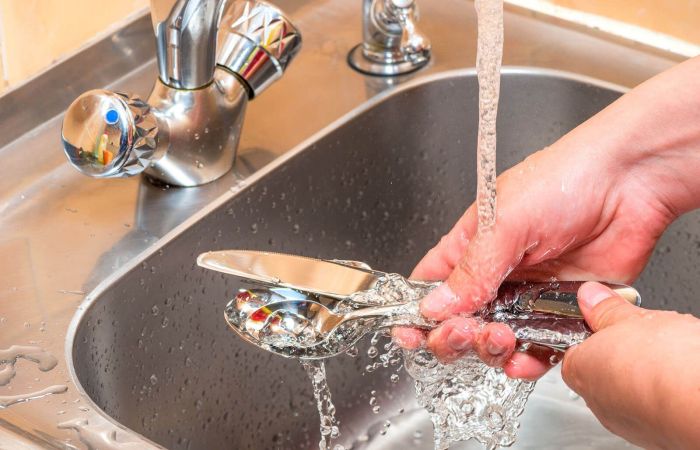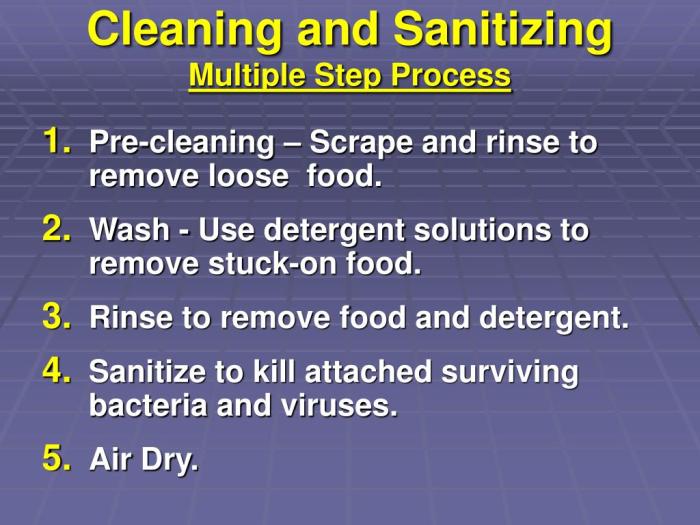Four steps in cleaning and sanitizing process – Maintaining a clean and sanitized environment is paramount for health and safety. This article presents a comprehensive guide to the four essential steps in cleaning and sanitizing processes: pre-cleaning, cleaning, rinsing, and sanitizing. Understanding these steps is crucial for effectively removing contaminants, preventing the spread of microorganisms, and ensuring a hygienic environment.
Four Steps in Cleaning and Sanitizing Process

Maintaining a clean and sanitized environment is crucial for various industries, including healthcare, food service, and manufacturing. A comprehensive cleaning and sanitizing process involves four distinct phases: pre-cleaning, cleaning, rinsing, and sanitizing. Each phase plays a specific role in ensuring the removal of contaminants and the prevention of microbial growth.
Pre-Cleaning Phase
Pre-cleaning is the initial step in the sanitization process and serves to remove visible soil and debris from surfaces. Common methods used for pre-cleaning include sweeping, dusting, and vacuuming. By removing loose particles, pre-cleaning facilitates the effectiveness of subsequent cleaning and sanitizing steps.
Cleaning Phase
The cleaning phase involves the use of detergents or cleaning agents to remove dirt, grime, and organic matter from surfaces. The selection of appropriate cleaning agents depends on the type of surface being cleaned and the nature of the contaminants present.
Manual cleaning techniques, such as scrubbing and wiping, can be used alongside mechanical methods, such as pressure washing or ultrasonic cleaning, to achieve effective cleaning.
Rinsing Phase
Rinsing is an essential step after cleaning to remove any residual cleaning agents or contaminants. Different methods can be employed for rinsing, including immersion in water, spraying, or wiping with a clean cloth. Thorough rinsing ensures that surfaces are free of cleaning agents and residues, which can interfere with the effectiveness of sanitizing agents.
Sanitizing Phase, Four steps in cleaning and sanitizing process
Sanitizing is the final step in the cleaning process and involves the use of chemical agents to reduce the number of microorganisms on surfaces to a safe level. Common sanitizing agents include chlorine, quaternary ammonium compounds, and hydrogen peroxide. The effectiveness of sanitization depends on factors such as contact time, temperature, and concentration.
Verification and Monitoring
Verifying the effectiveness of the cleaning and sanitizing process is crucial to ensure compliance with regulatory standards and maintain a safe and hygienic environment. Methods for monitoring cleanliness include ATP testing, visual inspection, and microbial sampling. Regular monitoring and record-keeping help identify areas for improvement and ensure accountability.
Training and Education
Proper training and education of staff on cleaning and sanitizing procedures are essential for maintaining a clean and safe environment. Training programs should cover topics such as the importance of hygiene, proper cleaning techniques, the use of appropriate cleaning agents, and the verification of cleanliness.
Ongoing training and refresher courses ensure that staff remains up-to-date on best practices and contributes to a culture of cleanliness.
Expert Answers
What is the purpose of pre-cleaning?
Pre-cleaning removes visible soil and debris, making the subsequent cleaning and sanitizing steps more effective.
What factors affect the effectiveness of sanitization?
Contact time, temperature, and concentration of the sanitizing agent are key factors that influence its efficacy.
Why is monitoring important in cleaning and sanitizing processes?
Monitoring ensures the effectiveness of the processes, identifies areas for improvement, and maintains compliance with regulations.


